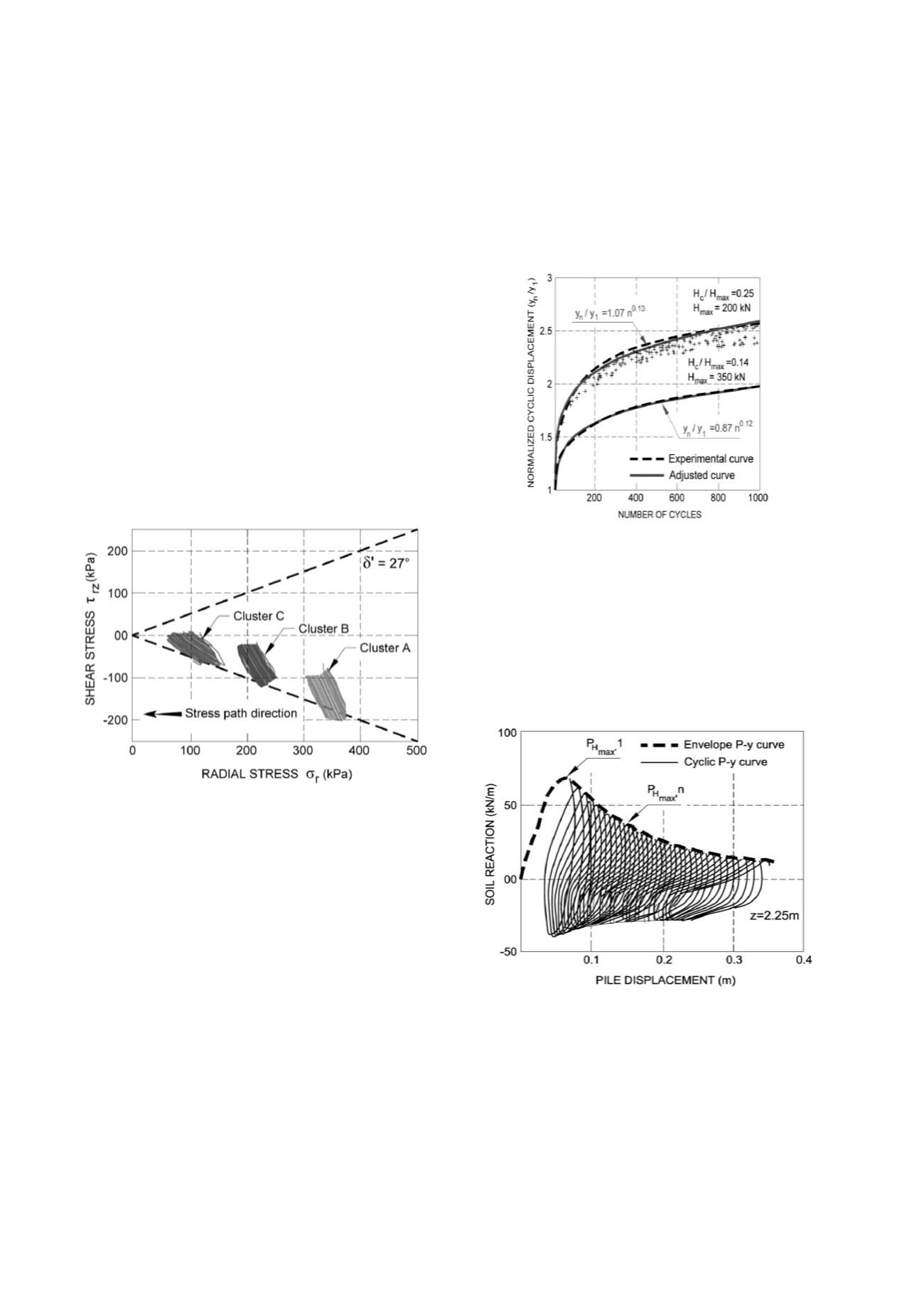

Proceedings of the 18
th
International Conference on Soil Mechanics and Geotechnical Engineering, Paris 2013, volume 6, 2016
2012). This concept is most applicable to short rigid piles, such
as those commonly used in construction and civil engineering.
Consequently, three types of approaches may be employed by
the designer:
-
"global" approaches
, which are solely focused on overall
pile behavior: evaluation of permanent displacement
accumulation at the pile head exposed to the effect of cycles,
degradation in load-bearing capacity;
-
"local"
approaches
, whereby the relationship between
potentially mobilized shear stress at the soil-pile interface and
local pile displacement is expressed by means of a so-called "
t-z
"
transfer curve. The challenge here lies in proposing cyclic "
t-z
"
curves as a complement to those recommended in current design
codes;
-
approaches based on the finite element method
.
SOLCYP's experimental layout has enabled advancing on all
3 of these approaches, and more specifically towards calibrating
the
t-z
curve generation algorithms provided in programs like
RATZ (Randolph, 1994) or SCARP (Poulos, 1989).
Fontainebleau sand tests performed in the calibration
chamber at the 3S-R facility have served to emphasize that the
loss of friction in the presence of cyclic loads is due to an abrupt
drop in effective radial stresses on the pile. This result is
illustrated in Figure 21, which shows the evolution in effective
stress paths (both radial and tangential) during cycling, as
measured at three levels along the pile wall.
Fig. 21: Stress path along a model pile wall, featuring: dense
Fontainebleau sand, a metastable test, and 1000 cycles (Silva
et al.
, 2013
)
These stress decreases could be simulated in the laboratory
(Pra-ai, 2013) via cyclic tests at an imposed normal stiffness (i.e.
CNS tests). Research efforts are currently focused on generating
a database in the form of interface laws capable of being
introduced "explicitly" into finite element models.
8.2.6
Piles subjected to a cyclic lateral loading
The response of piles subjected to a horizontal cyclic loading
was only studied experimentally within the scope of SOLCYP in
the case of flexible piles placed in the centrifuge. Many series of
one-way and two-way tests were conducted on instrumented
model
piles
cast-in-place
into
Fontainebleau
sand
(Rakotonindriana, 2009) and in both normally consolidated and
overconsolidated Speswhite kaolinite (Khemakhem
et al.
, 2012).
The primary objective of these tests was to derive the
degradation laws for comprehensive type analyses or for the
generation of degraded
p-y
curves.
The cycle effect is basically reflected by an accumulation of
displacements at the pile head, as well as by a gradual increase in
the maximum moment. The so-called global methods consist of
describing the evolution of these phenomena by laws of the type:
P(N)/P(1) = k.N
m
or P(N)/P(1) = 1+t.Ln(N)
where P(N) and P(1) are respectively the values of the property
described during cycles N and 1. m and t are the functions of:
loading characteristics (Qa and Qcy), soil-pile system stiffness,
and installation mode.
Fig. 22: Tests held in the centrifuge on normally consolidated clay -
Comparison of calculated and experimental curves for normalized
displacements
yn/y1
at the pile head (Khemakhem
et al.
, 2012)
Figure 22 illustrates the calibration process of a displacement
evolution law at the head of pile
y
vs. number of cycles, in the
form of a y(N)/y(1) = f(N) function for two pile-model tests in
the centrifuge with a normally consolidated clay. A program of
this type could be carried out in both sands and clays for
displacements as well as moments (Khemakhem
et al.
, 2012;
Rosquoët
et al.
, 2013). Garnier (2013) contains a summary of
these findings.
Fig. 23: Experimental P-y relations obtained during an alternated cyclic
test (H
c
/H
max
= 0.57) in normally consolidated clay (Khemakhem, 2012)
The global methods are capable of providing the designer
with a sufficient response in the case of homogeneous soils and
moderate cyclic loadings. For more complex cases, reliance on
the local method, based on the use of so-called
p-y
transfer
curves, becomes necessary.
Figure 23 exhibits the phenomenon of degradation due to
local reaction cycles subjected to the maximum load H
max
. This
degradation may be approximated with envelope curves like the
one proposed by API RP2GEO, though with this dual limitation:
Volume 6 - Page 92









